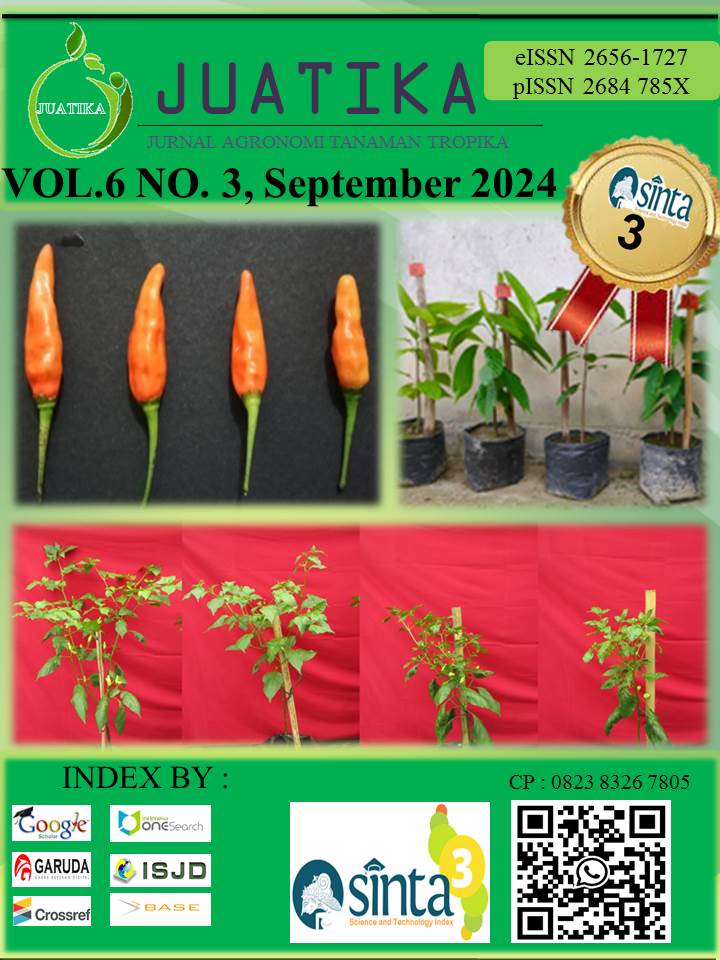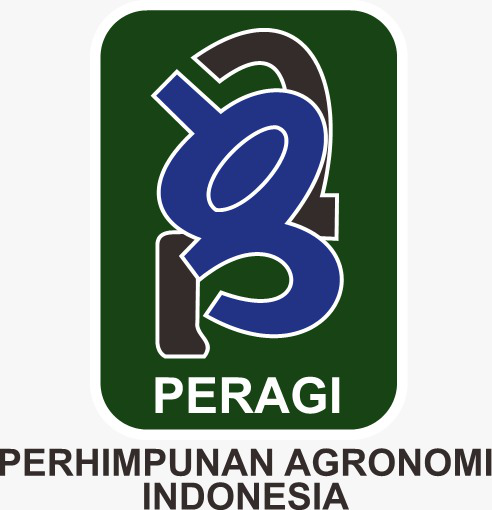Secondary Metabolite Profiles: Trichoderma, Aspergillus flavus Glocladium and Penicillium as Biocontrol Agents
Abstract
A fungus is utilized as a biocontrol agent to suppress plant diseases by employing an antagonistic mechanism, wherein it releases enzymes that degrade the cell walls of pathogens and inhibit their growth. The antibiosis mechanism is initiated by biocontrol fungi through the production of secondary molecules or metabolites. The objective of the research was to examine the secondary metabolite composition of the biocontrol fungi Trichoderma spp., Aspergillus flavus, and Gliocladium sp. and Penicillium species The implementation approach involved the use of qualitative phytochemical testing and HPLC analysis. The outcomes of the investigation into the metabolite profiles of Trichoderma spp., Aspergillus flavus, and Gliocladium sp. were observed. and Penicillium species The presence of alkaloids, phenolics, and flavonoids was detected in the samples. The results of the High-Performance Liquid Chromatography (HPLC) analysis indicated the presence of 10-11 compounds, as evidenced by the peaks observed in the chromatogram. These compounds are presumed to be associated with the phenolic and alkaloid groups.
Downloads
References
Abdelaziz, A. M., Kalaba, M. H., Hashem, A. H., Sharaf, M. H., & Attia, M. S. (2022). Biostimulation of tomato growth and biocontrol of Fusarium wilt disease using certain endophytic fungi. Botanical Studies, 63(1). https://doi.org/10.1186/s40529-022-00364-7
Abdelrahman, M., Abdel-Motaal, F., El-Sayed, M., Jogaiah, S., Shigyo, M., Ito, S. ichi, & Tran, L. S. P. (2016). Dissection of Trichoderma longibrachiatum-induced defense in onion (Allium cepa L.) against Fusarium oxysporum f. sp. cepa by target metabolite profiling. Plant Science, 246, 128–138. https://doi.org/10.1016/j.plantsci.2016.02.008
Aristyawan, A. D., Yuliarni, F. F., & Suryandari, M. (2024). Skrining Fitokimia Ekstrak Etanol Jamur Kuping Hitam ( Auricularia nigricans ) dengan Metode Soxletasi Phytochemical Screening Of Ethanol Extract 96 % Black Ear Mushroom ( Auricularia nigricans ) by soxletation method. 3(2), 114–123.
Chua, R. W., Song, K. P., & Ting, A. S. Y. (2022). Antimicrobial activities and phytochemical screening of endophytic fungi isolated from Cymbidium and Dendrobium orchids. South African Journal of Botany, 151, 909–918. https://doi.org/10.1016/j.sajb.2022.11.015
Hajlaoui, H., Arraouadi, S., Mighri, H., Ghannay, S., Aouadi, K., Adnan, M., Elasbali, A. M., Noumi, E., Snoussi, M., & Kadri, A. (2022). HPLC-MS Profiling, Antioxidant, Antimicrobial, Antidiabetic, and Cytotoxicity Activities of Arthrocnemum indicum (Willd.) Moq. Extracts. Plants, 11(2). https://doi.org/10.3390/plants11020232
Hazarika, D. J., Kakoti, M., Boro, R. C., & Bhattacharyya, A. (2022). Biocontrol applications of microbial metabolites. In Biocontrol Mechanisms of Endophytic Microorganisms (pp. 181–216). Elsevier. https://doi.org/10.1016/B978-0-323-88478-5.00010-9
Hikmahwati, Fitrianti, & Karim, H. A. (2021). Rhizosphere Mushrooms : Antagonistic Exploration of Rhizospere Mushrooms in Shallot ( Allium ascolonicum L ) Specific Location of Enrekang Regency. International Journal of Scientific Research in Science and Technology Print, 8(6), 428–433. https://doi.org/10.32628/IJSRST218520
Hikmahwati, Suharman, & Fitrianti. (2022). Rhizospheric Fungus : Morphological Characterization Of Rhizosphere Flower On Onion Plant In Enrekang District. Juatika Jurnal Agronomi Tanaman Tropika, 4(1).
Kamble, M. V., Joshi, S. M., Hadimani, S., & Jogaiah, S. (2021). Biopriming with rhizosphere Trichoderma harzianum elicit protection against grapevine downy mildew disease by triggering histopathological and biochemical defense responses. Rhizosphere, 19. https://doi.org/10.1016/j.rhisph.2021.100398
McMurry, J. (2012). Organic Chemistry (8th ed.). Brooks/Cole, Cengage Learning.
Nguyen, P. A., Strub, C., Fontana, A., & Schorr-Galindo, S. (2017). Crop molds and mycotoxins: Alternative management using biocontrol. In Biological Control (Vol. 104, pp. 10–27). Academic Press Inc. https://doi.org/10.1016/j.biocontrol.2016.10.004
Nofal, A. M., El-Rahman, M. A., Abdelghany, T. M., & Abd El-Mongy, M. (2021). Mycoparasitic nature of Egyptian Trichoderma isolates and their impact on suppression Fusarium wilt of tomato. Egyptian Journal of Biological Pest Control, 31(1), 1–8. https://doi.org/10.1186/s41938-021-00450-1
Nurulita, Y., Yuharmen, Y., Nenci, N., Mellani, A. O., & Nugroho, T. T. (2020a). Metabolit Sekunder Sekresi Jamur Penicillium spp. Isolat Tanah Gambut Riau sebagai Antijamur Candida albicans. Chimica et Natura Acta, 8(3), 133. https://doi.org/10.24198/cna.v8.n3.32452
Pamekas, T. (2020). Respon pertumbuhan cendawan patogenik Fusarium oxysporum terhadap metabolit sekunder cendawan antagonis Trichoderma sp. PENDIPA Journal of Science Education, 4(3), 75–81. https://doi.org/10.33369/pendipa.4.3.75-81
Pascale, A., Vinale, F., Manganiello, G., Nigro, M., Lanzuise, S., Ruocco, M., Marra, R., Lombardi, N., Woo, S. L., & Lorito, M. (2017). Trichoderma and its secondary metabolites improve yield and quality of grapes. Crop Protection, 92, 176–181. https://doi.org/10.1016/j.cropro.2016.11.010
Pereira-Dias, L., Oliveira-Pinto, P. R., Fernandes, J. O., Regalado, L., Mendes, R., Teixeira, C., Mariz-Ponte, N., Gomes, P., & Santos, C. (2023). Peptaibiotics: Harnessing the potential of microbial secondary metabolites for mitigation of plant pathogens. Biotechnology Advances, 68(August). https://doi.org/10.1016/j.biotechadv.2023.108223
Pradhan, D. A., Bagagoni, P., & Makandar, R. (2023). Assessing rhizosphere Trichoderma asperellum strains for root colonizing and antagonistic competencies against Fusarium wilt through molecular and biochemical responses in castor. Biological Control, 184, 105280. https://doi.org/10.1016/J.BIOCONTROL.2023.105280
Rohmawati, E. S., & Harahap, I. (2017). Isolasi dan karakterisasi senyawa antifungi isolat cendawan endofit dari tumbuhan senduduk (Melastoma malabathricum L.). Prosiding Celscitech-Umri 2017, 2, 43–49.
Suhendar, U., Fathurrahman, M., & Sogandi, S. (2019). Antibacterial Activity and Mechanism of Action of Methanol Extract from Kasturi Mango Fruit (Mangifera casturi) on Caries-Causing Bacterium Streptococcus mutans. Jurnal Kimia Sains Dan Aplikasi, 22(6), 235–241. https://doi.org/10.14710/jksa.22.6.235-241
Sukmawaty, E., Hafsan, H., Masri, M., Shintia, I., Wahyuni, S., & Amir, U. N. A. (2021). Skrining Fitokimia dan Aktivitas Antioksidan Ekstrak Etil Asetat Cendawan Endofit Aspergillus sp. BIOTIK: Jurnal Ilmiah Biologi Teknologi Dan Kependidikan, 8(2), 218. https://doi.org/10.22373/biotik.v8i2.8194
Theowidavitya, B., Muttaqin, M., & Tjahjoleksono, A. (2019). Analisis Metabolomik Pada Interaksi Padi dan Bakteri Metabolomics Analysis on the Interaction of Rice and Bacteria. Sumberdaya Hayati , 5(1), 18–24. http://biologi.ipb.ac.id/jurnal/index.php/jsdhayati
Ujam Nonye Treasure, Abba Chika Christiana, Eze Peter Maduabuchi, Oli Angus Nnamdi, Ejikeugwu Chika Ebiye, Ugwu Malachy Chigozie, Okoye Festus Basden Chiedu, & Esimone Charles Okechukwu. (2020). The isolation, identification and antimicrobial activities of endophytic fungi from Azadirachta indica. GSC Biological and Pharmaceutical Sciences, 11(3), 115–124. https://doi.org/10.30574/gscbps.2020.11.3.0171
Warsito, M. F. (2018). Analisis Metabolomik : Metode Modern dalam Pengujian Kualitas Produk Herbal Mega Ferdina Warsito. BioTrends, 9(2), 38–47.
Yassin, M. T., Mostafa, A. A. F., & Al-Askar, A. A. (2021). In vitro antagonistic activity of Trichoderma harzianum and T. viride strains compared to carbendazim fungicide against the fungal phytopathogens of Sorghum bicolor (L.) Moench. Egyptian Journal of Biological Pest Control, 31(1). https://doi.org/10.1186/s41938-021-00463-w
Zeilinger, S., Gruber, S., Bansal, R., & Mukherjee, P. K. (2016). Secondary metabolism in Trichoderma - Chemistry meets genomics. In Fungal Biology Reviews (Vol. 30, Issue 2, pp. 74–90). Elsevier Ltd. https://doi.org/10.1016/j.fbr.2016.05.001
Copyright (c) 2024 Nur Ilmi, Sogandi , Hikmahwati hikmahwati Hikmahwati, Abdul Azis Ambar

This work is licensed under a Creative Commons Attribution 4.0 International License.
Authors who publish with Jurnal Agronomi Tanaman Tropika (JUATIKA) agree to the following terms:
Authors retain copyright and grant the Jurnal Agronomi Tanaman Tropika (JUATIKA) right of first publication with the work simultaneously licensed under a Creative Commons Attribution License (CC BY 4.0) that allows others to share (copy and redistribute the material in any medium or format) and adapt (remix, transform, and build upon the material for any purpose, even commercially) with an acknowledgment of the work's authorship and initial publication in Jurnal Agronomi Tanaman Tropika (JUATIKA).
Authors are able to enter into separate, additional contractual arrangements for the non-exclusive distribution of the journal's published version of the work (e.g., post it to an institutional repository or publish it in a book), with an acknowledgment of its initial publication in Jurnal Agronomi Tanaman Tropika (JUATIKA). Authors are permitted and encouraged to post their work online (e.g., in institutional repositories or on their website) prior to and during the submission process, as it can lead to productive exchanges, as well as earlier and greater citation of published work.







 More Information
More Information


